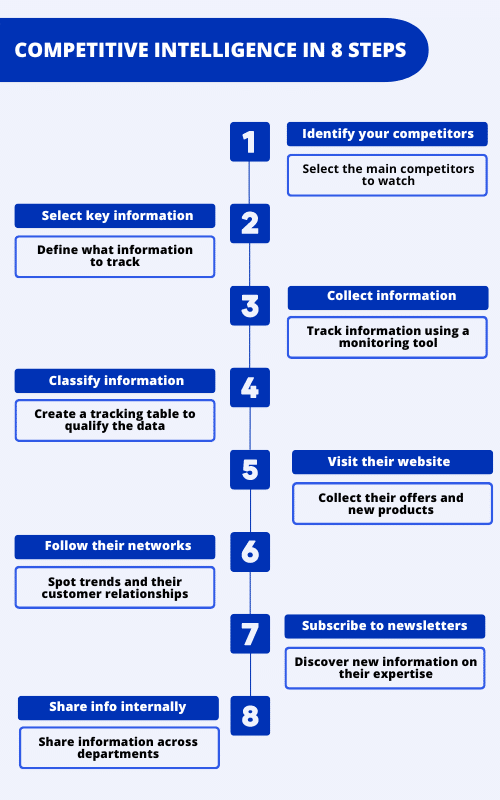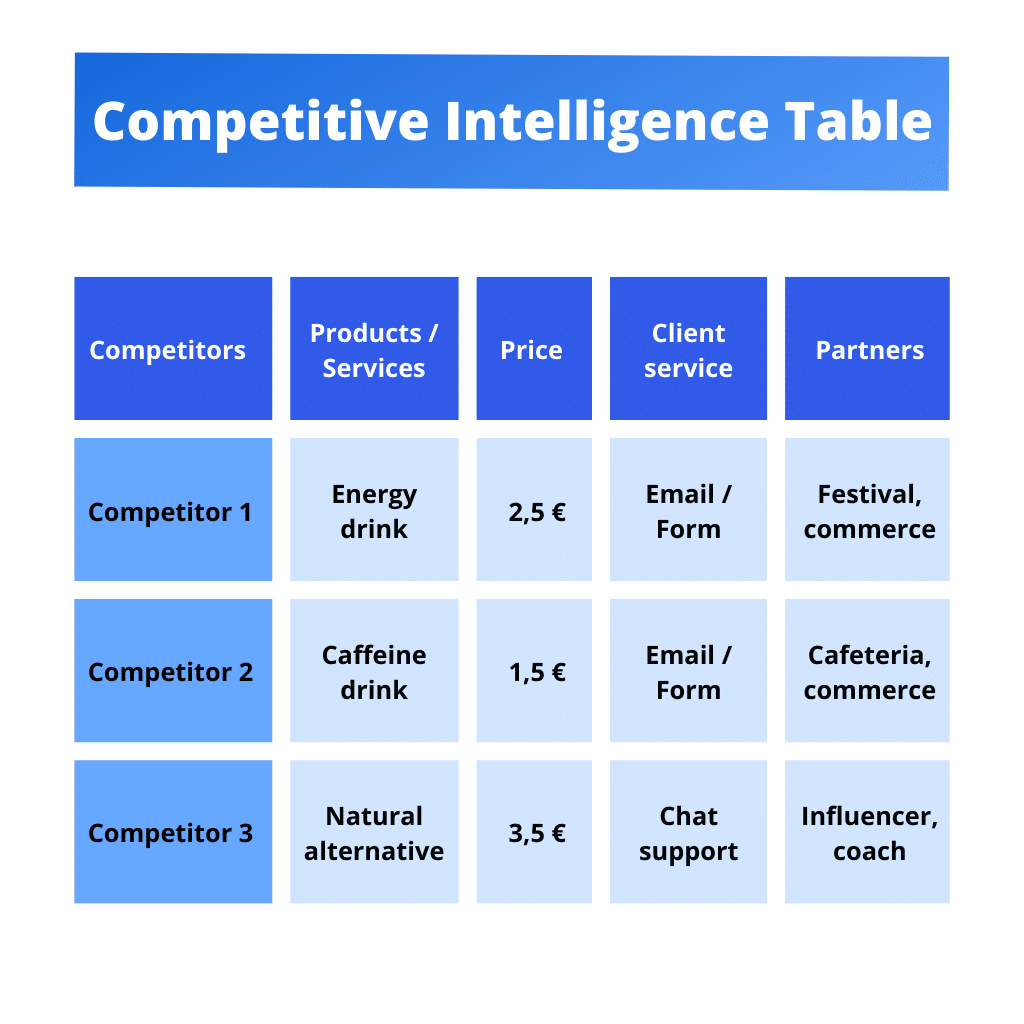Competitive intelligence is essential for anticipating the movements of existing or future competitors. 🔮 In this article, you’ll find the steps you need to take to create an effective competitive intelligence system.
What is Competitive Intelligence? Definition
The competitive intelligence definition is the strategy used to know and understand the competitive environment, 🧠 to predict future strategic actions, or to derive better business practices, new techniques, marketing, etc., from it.
Competitive intelligence is a set of methods that companies use to constantly monitor the actions and products of their current or potential competitors. ⚡ This marketing strategy enables company decision-makers to adjust their strategies.
Now that you know about competitive intelligence def, 👇 let’s take a look at some examples!
Competitive Intelligence Examples
Let’s take a look at some competitive intelligence examples: 👇
- Apple: exercises in-depth technological intelligence to stay at the forefront of innovation. 📱 The company keeps a close eye on the technological developments of its competitors in the smartphone and wearable technology field, enabling it to adapt its offerings and technologies accordingly.
- Coca-Cola: conducts intensive marketing surveillance and analyzes the advertising campaigns and promotions of competitors such as Pepsi. 🥤 This enables Coca-Cola to adapt its messages and promotions to better capture consumer attention and increase its market share.
- Amazon: practices price intelligence by constantly monitoring the prices of its e-commerce competitors. 📦 The company uses sophisticated algorithms to adjust prices in real time to maximize profits while remaining competitive.
These companies demonstrate how effective competitive intelligence can have a direct impact on strategy and success in various sectors! 💥
How to do Competitive Intelligence Analysis? Tips
Competitive intelligence is essential for any company, in any industry… ⚡ That’s why we’re giving you the following tips for successful research:

1. Identify your Competitors
Competitive intelligence research naturally starts with choosing your competitors. 🫵
In other words, you need to create a list of companies that target the same market as you and sell products and services similar to yours.
Once you have created this list, divide it into three different categories: ⏬
- Direct competitors: those who target the same audience and offer similar products or services.
- Indirect competitors: you offer another product/service that meets the same needs as theirs.
- Tertiary (or alternative) competitors: they offer different products or services from yours, but target the same audience. Their usefulness is limited to the fact that they can become partners or threats.
If you want to know more about direct and indirect competitors, here’s a dedicated article! 💖
2. Select Key Information
Gathering information on the Internet is a good thing, but you have to know how to search. 🙊
The web is full of a wide variety of information, from networks to wiki-style sites to AIs… 🔎 To stay on track and locate reliable sources, you need to ask yourself the right questions.
Project management software with mind maps is a great tool for getting started. 👌 It helps you identify the data you require and the data you don’t need.
To get there, start by asking yourself these three key questions:
- Who are your competitors?
- Who their customers are,
- Who their suppliers are.
The key to competitive intelligence is to have enough knowledge to stay one step ahead of your competitors’ potential developments. 🏃
By considering these three key points, you’ll know what information you need to do your competitive analysis. 🤓 You’ll learn more about your competitors’ potential impact on your environment.
3. Gather Information
To do this properly, you need the right search tools. 🕵️ And there are plenty of them on the Internet, so here’s our Top 5 tools:
- SEMrush: ☄️ This popular tool for SEO and SEM analysis provides detailed information on your competitors’ keyword strategies, web traffic, and advertising.
- Ahrefs: 🔥 Ahrefs is particularly useful for backlink analysis and tracking SEO rankings. It also provides valuable data on the health and performance of a website’s content.
- BuzzSumo: 💥 BuzzSumo is great for analyzing social media content and engagement, helping you understand what type of content marketing works well in your industry and who the top influencers are.
- SpyFu: 🧨 This tool is great for spying on your competitors’ keywords and Google Ads strategies, allowing you to see what keywords they are buying and what types of ads they are running.
- Brandwatch: ⚡ offers advanced social data analytics, Brandwatch is perfect for monitoring mentions of your branding and competitors across social media and the web, providing real-time insights.
These tools significantly improve your ability to monitor and analyze your competitors’ activity in various areas, 🔍 from SEO performance to social media engagement.
With time and practice, you’ll find the one that best suits your needs. 👉 As you can see, you’ll find plenty of answers on the internet, but don’t just focus on that.
Talk to your sales team too! 👂 Because they’re in direct contact with stakeholders, providers, and even competitors.
In the next section, we’ll take a look at some monitoring tools available. 💫
4. Classify the Information
Once all the data has been collected, process and enhance the information by highlighting the most relevant. 👉 To do this, create a monitoring table (we’ll talk about it shortly).
This is the easiest way to categorize and compare data by competitor, subsidiary, market, or supplier. 📊 You’ll quickly notice that some of them are useless, duplicative or of poor quality.
Next, select the information source you wish to automate on your dashboard. To be effective, competitor monitoring must be carried out on an ongoing basis.
💡 For this, prefer e-mail notifications/alerts or RSS feeds. All competitive intelligence software now offers this.
5. Visit their Website
Visiting your competitors’ websites is a quick and effective way to find out what they offer, what’s new and how it’s presented. ✍️ Take note of what your competitors are offering and see what’s wrong.
Sometimes it can be difficult to find important information such as phone numbers, contact email addresses and even detailed company info. 👀
You can also check out their recruitment section to see the areas they’re looking to develop through these new positions. 🤔
Browsing your competitors’ websites is also a good way to gather a competitive intelligence database on new products or services, to better understand their positioning and strategic points you didn’t know about. 🫢
6. Follow them on Social Networks
Competitive intelligence on social networks is essential for understanding your competitors’ new strategies and adapting your marketing efforts. 💪
Here are a few tips to maximize the effectiveness of your watch:
- Use specific tools: invest in a monitoring tool like SproutSocial or Hootsuite to track your competitors’ activity in real time.
- Analyze interactions: evaluate interactions (likes, comments, shares) with your competitors’ publications to identify content that resonates with your target audience.
- Monitor hashtags: identify and follow the hashtags your competitors are using to discover trends and new topics.
- Listen to feedback: pay attention to competitor mentions and related discussions to understand customer feedback and preferences.
These techniques will help you increase your presence on social networks and stay competitive in your industry. 🏆
7. Subscribe to their Newsletter
What better way to spy on your competitors than to follow their newsletters? 😏
These are a valuable source of knowledge about their business and market trends in your field! 💎
You can often subscribe to newsletters via their website homepage or social network pages. 🪶
This will help you see your competitors from the customer’s point of view. 🔬 You can draw inspiration from the elements described in these e-mails.
👉 It’s always interesting to discover different perspectives from your own.
However, don’t use your business e-mail address, as it could be blacklisted. So be careful. 🔕
8. Share Information Internally
Finally, encourage information sharing within your teams. 🤝
It’s important to encourage info sharing. 👉 For example, stories from customers who have had a bad experience with one of your competitors will certainly be of interest to your sales people and those responsible for customer experience within your company.
These exchanges are full of interesting information about their pricing (and advertising) policies, customer acquisition channels, etc. 👂 So listen up!
Next comes distribution. 📣 Every department, every sales team, needs to receive data addressed to them. This enables you to make appropriate strategic decisions based on the competitive landscape and internal environment.
The aim is to list the results found by the desired service. ✍️ Organizing training sessions on the data collected will ensure a deeper understanding of the issues at stake.
This information can therefore be presented in the form of a competitive intelligence report and distributed to teams via a Slack channel for the department concerned, for example. 😊
What Competitive Intelligence Tools Should you use?
Finally, we’ll introduce you to a few competitive intelligence tools, so you can get started on your research! 👇
1. Competitive Intelligence Report
Competitive intelligence tables represent a central management tool, enabling the following elements to be integrated for strategic decision-making: ⏬
- Your competitors’ products and services,
- The prices of these products/services,
- Their type of customer service,
- Their main partners,
- Etc.
This tool can be adapted to suit the company’s development objectives. 👉 This could be, for example, the development of a new product, the company’s appearance on a new social network or the opening of a new store. 🏪
The easiest way to create a competitive intelligence table is to use a collaborative spreadsheet like Excel or Google Sheets, where all participants can add or modify data. 📄

2. Competitive Intelligence Software: RSS Feed Tools
We’ve already seen that with RSS feed tools, you can automate the collection of competitive info at different levels. 🥸
You can save precious time with features like: ⏬
- Browse multiple websites from a single interface.
- Define alerts based on strategic keywords.
👉 Most, like Feedly, are available free of charge. The paid version offers additional features such as note creation and content storage. 💰 In terms of budget, although the site offers to try the service for free, you can choose a subscription that costs $6 a month for the Pro version and $12 a month for the Pro+ version.
👉 Google Alerts is a free service that allows you to receive e-mail updates on the latest search results for specific searches. 🛎️ This service helps you to effectively monitor new developments that could have an impact on the overall market and your e-commerce business.
👉 Finally, the Talk Walker tool uses artificial intelligence to analyze billions of pieces of customer info on various online platforms such as social networks and forums. 🤖 To help you better understand and anticipate consumer needs. The competitive intelligence platform offers a free demo, but a year’s use costs around 6,000 euros.
In conclusion, RSS tools automate certain operational competitive intelligence tasks, which is not possible with simple dashboards. 💼
3. Follow-up on Social Networks
Social networks are brimming with information on the competitive environment. 🤩 Above all, LinkedIn enables a more professional approach. It’s a network where CEO voices are heard.
As far as marketing is concerned, social media monitoring is a good starting point for determining audience engagement rates. 👉 More broadly, this approach provides access to the latest news from the businesses you’re interested in, as well as valuable data on their sector.
4. Competitive Intelligence Analyst: Field Survey
For some areas of business, a field survey is the most suitable competitive intelligence solution. 🌱 Indeed, when a competitive intelligence analyst visits the premises, they will have access to more information than what’s available online.
Field research, on the other hand, requires the development of plans to « infiltrate » competitors more or less anonymously depending on the situation. 🤫 The main disadvantage is that you need to devote time and have the objectives of the competitive intelligence process in mind before you start.
How do you Analyze the Results of your Competitive Intelligence?
Here are some key steps for analyzing the results of your competitive intelligence: 👇
1. Study the Information Collected
- The study of competitive intelligence data begins with a detailed assessment of the information collected. 💡 Identify marketing trends, new competitor strategies and technological developments likely to have an impact on your sector.
- Use analysis tools to segment your data and isolate key variables. 🗝️ It’s important to distinguish between critical information that can have a direct impact on your business and less relevant data.
2. Set up an Action Plan
- Following your analysis, create a targeted sales planning to match or stay ahead of your competitors’ strategies. 🎯 This plan may include adjusting your marketing strategy, developing new products or ways of exploiting identified weaknesses.
- Prioritize actions according to their potential impact and feasibility. 👍 It’s also important to define key performance indicators (KPIs) to measure the effectiveness of these initiatives over time.
Following these steps will not only help you understand what your competitors are doing, but also help you stay proactive in an ever-changing market. 🧨
Conclusion: Why is Competitive Intelligence important?
Now that the goals of competitive intelligence are clear, 🧊 here are a few ways to analyze your competitors and set up an approach to better understand your market:
- Anticipate your competitors’ next offers,
- Identify strategic developments in your market (geographical, marketing, recruitment, etc.),
- Position your company for better market & brand positioning, while remaining aware of the pricing policies applied,
- Analyze your brand’s competitiveness and reputation in relation to your market.
Finally, competitive intelligence is a powerful tool that is still under-utilized by companies. However, it allows you to stay informed and keep an eye on the competitive environment. 👀
Whether you use free or paid competitive intelligence tools, information management and processing must be a key strategy in your company’s development! 🚀
FAQ : Competitive Intelligence Industry
What is Competitive Intelligence in Marketing?
Competitive intelligence in marketing is a systematic process by which companies collect, analyze and use information about the competitive environment 🌎 to make strategic decisions and maintain or improve their market position.
The main aspects of competitive intelligence in marketing are: 👇
- Information gathering: companies collect data on their competitors from various sources, including websites, social networks or annual reports.
- Competitive intelligence analysis: the information gathered is analyzed to identify market trends, understand competitive strategies and identify opportunities and threats (see SWOT analysis).
- Strategic decision-making: these analyses help businesses to adjust or develop marketing plans to improve their competitiveness.
- Continuous monitoring: monitoring is an ongoing process that enables you to adapt your strategy to rapid changes in the market and respond proactively to competitors’ actions.
In short, marketing intelligence helps companies stay informed about the market and make informed decisions to maintain or improve their competitive edge. 🔥
What are the Different Types of Competitive Intelligence?
Competitive intelligence can be classified into different types, each targeting a specific aspect of the competitive environment: ⏬
- Product intelligence: analyze the functionalities, innovation, and performance of competing products to adapt or develop new offers.
- Price watch: monitor competitors’ price changes and pricing strategies to optimize your pricing policies.
- Technology watch: Monitor technological advances and the adoption of technology by competitors to stay at the forefront of innovation.
- Marketing intelligence or sales intelligence : Study your competitors’ campaigns, promotions, and communication strategies to improve your marketing efforts.
- Strategic intelligence: Gathering information on competitors’ strategic plans and changes to predict their movements in the market.
Monitoring in all its forms is essential to maintain or improve your competitiveness in a dynamic market environment. 🌐
Now you know all about competitive intelligence. See you soon! 😉









